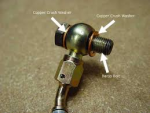I have been trying to flush my brake fluid for nearly 1 week. Fluid does not seem to be getting from the reservoir to the master cylinder.
Backstory: 2005 sportster with dual front brakes.
-over the winter I replaced the handlebars and fork seals. during this time I had the front brake system laying in a pile.
-the new handlebars are lower causing an S-shaped loop in the brake line similar to the trap under a sink
-I noticed this spring that the front brakes were nearly non-existent and the brake light was sticking on.
-The brake fluid looked pretty brown so I decided to try giving it a flush. looked pretty easy via youtube.
-tried the usual pumping and opening the bleed valve but very little came out. Also, no matter what it would eventually suck air back in on the second of third bleed.
-tried letting it sit with the bleed valves open and have gravity do its thing and in the last week have gotten maybe 1/2 cup of brake fluid out.
-tried vacuuming which does get fluid out but it seems like air just gets pulled back into the caliper as soon as I'm done.
-tried putting about 15psi of compressed air on the bleed screw thinking there could be a blockage somewhere. no plugs. fluid shot out of the master cylinder (luckily dot5 silicone based because it was everywhere)
-pulled the brake line off of the master cylinder and there was almost no fluid in the cylinder.
-I was not able to pump up pressure as there was no fluid coming into the cylinder and not air bubbles coming up into the reservoir
-I sprayed brake cleaner in every orifice I could access and I started to get some small bubbles in the reservoir when pumping the lever so I reassembled and still can't pump up any pressure on the lever or get fluid out of the caliper without pulling air back in.
I'm about to order a master cylinder rebuild kit from Harley but its 2 weeks out. Does the master cylinder make sense?
Backstory: 2005 sportster with dual front brakes.
-over the winter I replaced the handlebars and fork seals. during this time I had the front brake system laying in a pile.
-the new handlebars are lower causing an S-shaped loop in the brake line similar to the trap under a sink
-I noticed this spring that the front brakes were nearly non-existent and the brake light was sticking on.
-The brake fluid looked pretty brown so I decided to try giving it a flush. looked pretty easy via youtube.
-tried the usual pumping and opening the bleed valve but very little came out. Also, no matter what it would eventually suck air back in on the second of third bleed.
-tried letting it sit with the bleed valves open and have gravity do its thing and in the last week have gotten maybe 1/2 cup of brake fluid out.
-tried vacuuming which does get fluid out but it seems like air just gets pulled back into the caliper as soon as I'm done.
-tried putting about 15psi of compressed air on the bleed screw thinking there could be a blockage somewhere. no plugs. fluid shot out of the master cylinder (luckily dot5 silicone based because it was everywhere)
-pulled the brake line off of the master cylinder and there was almost no fluid in the cylinder.
-I was not able to pump up pressure as there was no fluid coming into the cylinder and not air bubbles coming up into the reservoir
-I sprayed brake cleaner in every orifice I could access and I started to get some small bubbles in the reservoir when pumping the lever so I reassembled and still can't pump up any pressure on the lever or get fluid out of the caliper without pulling air back in.
I'm about to order a master cylinder rebuild kit from Harley but its 2 weeks out. Does the master cylinder make sense?















